Before the advent of nanotechnology and an abundance of works on designing a nanocomputer, when one talked about computers one might mean an original mainframe computer, a mini computer, or a microcomputer. The powerful mainframe computers served for statistics, planning, and processing of big data sets such as those concerning the census, government, industry, or consumers. They included the central processing unit, main memory, hosted multiple operating systems, and operated virtual machines – the guest operating systems with software implementation of a computer enabling the execution of the operating system or running programs aiding the single processes.
Mini computers, introduced in mid-1960s cost about $25,000; they had input-output devices such as a teleprinter and memory capable of running higher-level language programs such as Fortran or Basic.
Microcomputers, often called personal computers and designed for individual users, did not need big cabinets or special rooms. They contained a microprocessor, a central processing unit (CPU), a power supply unit, RAM memory, memory storage devices combined with the CPU, batteries, and integrated or separate input/output devices for conveying information such as monitors, keyboards, printers, and other human interface devices. Some of them became personal computers.
.
Carbon in a nanoscale: Nanocomputers
Advances in building nanocomputers bring about thinking about the role of carbon in computers, namely carbon in the nanoscale dimension in the form of carbon nanotubes. A nanocomputer has its parts no bigger than a few nanometers. There are no commercially available nanocomputers yet; they exist both in computer science and in science fiction. Nanocomputers might be built using mechanical, electronic, biochemical, or quantum mechanics principles.
Computer scientists are working toward building nanoscale computers that would be significantly faster and combine high computing power with low electrical requirements. Nanotubes allow reducing the size of chips and lowering physical limitations that prevent them from functioning reliably. Chips would contain a great number of electronic switches (50–100 nanometers in size). Grids of nanotubes may form memory and very fast operating circuits. With the Stanford team’s approach, the digital integrated systems would possibly comprise arithmetic circuits, sequential storage, as well as the monolithic three-dimensional integrated circuits with extreme levels of integration (Science Daily, 2012). Nanoscale computers would be portable, wearable or implantable. The small, nanoscale size of such computers would make them faster. Applications of nanoscale products would include carrying big data and information sets, detecting diseases and monitoring treatment, creating probes to detect single molecules, or constructing smart materials for turbine engines and body armor.
In 1965, Gordon Moore, one of the founders of the maker of computer chips Intel, predicted that the number of electronic switches and other devices put on a single chip would double every 18 months. It is still happening, with the smaller and faster chips. Nanosize chips would be ten-thousandths of an inch on a side and hold thousands bits of memory. That would involve thousands junctions, each of which would represent a “0” or “1” in digital language. Individual junctions would open and close billions of times per second, hundreds of gigahertz. A hybrid approach would allow making the nanotube junction switches by combining silicon nano wires with carbon nanotubes, to make it easier to connect switches on a chip and chips in the computer.
Chips have been made of silicon, which as the main ingredient of sand is one of the most abundant, available in large quantities elements on Earth. The decrease in the size of silicon transistors in order to increase their speed causes increased energy consumption. Now, silicon will have to be replaced in order to further miniaturize electronic systems and make them faster. Silicon transistors in computers may be replaced by transistors based on carbon nanotubes, when nanotubes would replace traditional silicon technologies and produce smaller and faster components. By exchanging the silicon for a carbon nanotube, the transistors can be made both smaller and faster. Miniaturization of electronic systems depends on attaining energy efficiency. Application of carbon nanotubes circuit will possibly help to solve the challenge of energy efficiency, as they could provide a ten-times improvement in energy efficiency over silicon.
However, nanotube transistors display material imperfections inherent to carbon nanotubes. Some carbon nanotubes are semiconducting and they can be used in transistors. Metallic carbon nanotubes (that are not semiconducting) may often cause short circuits, excessive power leakage, and susceptibility to noise. Existing nanotube synthesis techniques do not produce exclusively semiconducting nanotube solutions. Teams of engineers are now working on securing the carbon nanotubes’ viability to complement silicon CMOS (complementary metal–oxide–semiconductor) transistors that would have high noise immunity and low static power consumption. The Stanford engineers are working on developing a synthesis technique where the full-wafer-scale digital logic structures would be unaffected by misaligned and mis-positioned carbon nanotubes (Science Daily1, 2012).
Connecting nanotubes to form large circuits creates another problems. Integrating nanotubes into larger circuits entails the difficulty of manufacturing good metal contacts for the tubes (Science Daily2, 2012). Concerns are also about the perfect alignment of nanotubes without stray conducting paths and faulty functionality into the circuits, making reliable junctions between nanotubes, and assembling junctions between the arrays of switches that would form workable computer memory or logic circuits enabling the computer to make choices. Application of an electrical field guides the carbon nanotubes as they grow randomly (Svensson, 2010).
Biologically-inspired models for practical computing
Nanocomputers might be built using biochemical principles. Study of biological systems can significantly improve computing, networking, and robotics. Bio-inspired models utilize information gathered from animal social systems. Artificial life (ALife) denotes the creation of synthetic life on computers to study, simulate, and understand living systems. According to Kim & Cho (2006), ALife application fields include robot control, robot manufacturing, practical robots, computer graphics, natural phenomenon modeling, entertainment, games, music, economics, Internet, information processing, industrial design, simulation software, electronics, security, data mining, and telecommunications. Methods for designing such applications include evolutionary computation, swarm intelligence, artificial immune network, and agent-based modeling. Biologically inspired evolutionary robotics (ER) is a powerful approach for the automatic synthesis of robot controllers. (Trianni & Nolfi, 2011).
A challenge in constructing models is in incorporation of variables such as internal states: hunger, sex, drive, and higher functions: learning, memory, and personality into the models. As stated by Bales & Kitzmann (2011), a biologically inspired model for computing is any model of communication that displays evolution (a selection process that acts on variation). Most models focus on social systems. Computing scientists examine most often social insects, which display emergent behavioral properties of individuals that do not require centralized command, but also packs of wolfs, schools of fish, flocks of birds, and other social animals. Animal communication is shaped by natural selection and adaptation, which requires plasticity. Signals may last long, for example, chemical signals, or may be transient like acoustical ones. Animals communicate with members of their own species and of another species. They effectively convey information about functions they perform, such as foraging and predator defense, maximizing the success of both the sender and the receiver, while minimizing the cost of signaling. Some signal modalities (modes of communication may differ from those used by humans and may include chemical (pheromones), electrical, and seismic signals (for example, when blind mole rat transmits signals over long distances by thumping on burrow walls). An unsuccessful ant will switch to the task that the successful one is performing. It means a worker ant assesses its own success. In social insects individuals respond to stimuli in a similar way. The resulting emergent property, referred to as swarm intelligence, has been compared to distributed, parallel computing. Biologically inspired evolutionary robotics (ER) is a powerful approach for the automatic synthesis of robot controllers. Creation of collective and swarm robotics may be inspired by the property that the desired behavior of the social group is an indirect result of the control and communication rules followed by each individual (Trianni & Nolfi, 2011).
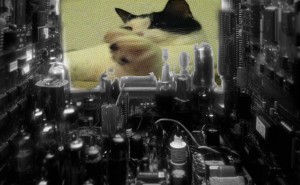


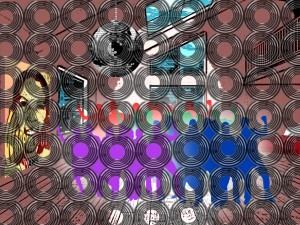
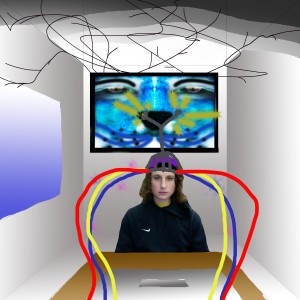
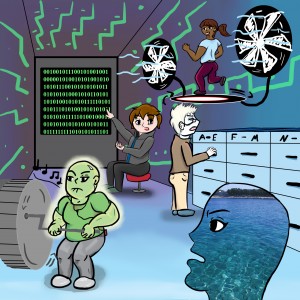

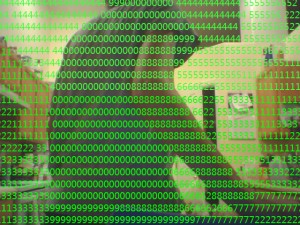
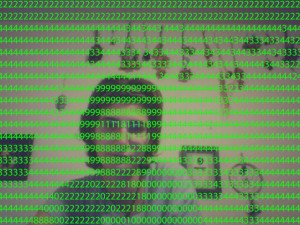
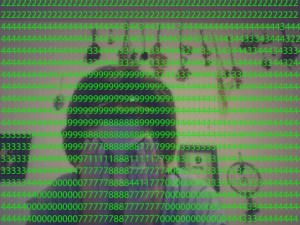

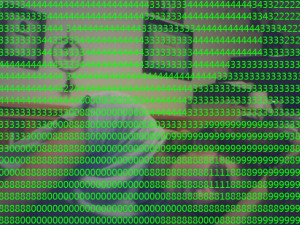

A collection of responses to a question how a computer might see us.
Lauren Arline
Computer Graphics
Artist Statement
I wanted to create a view through the speakers of a computer. I wanted a view as the speakers are in use through a party. I wanted to create a fun, lighthearted theme of people having fun and enjoying friends, which reflects on my personality. I created multiple colors in order to emphasize my theme. I used the silhouettes of people as a sort of symbolism to show that I like meeting new people.